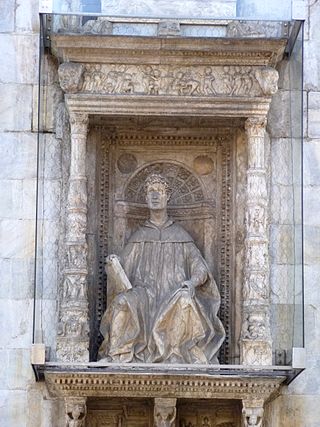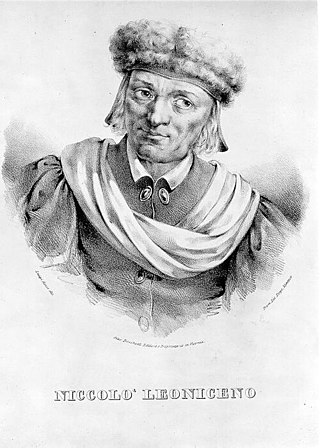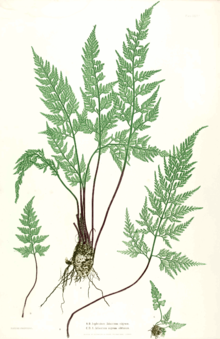
Abracadabra is a magic word, historically used as an apotropaic incantation on amulets and common today in stage magic. It is of unknown origin.

Gaius Plinius Secundus, called Pliny the Elder, was a Roman author, naturalist, natural philosopher, naval and army commander of the early Roman Empire, and a friend of the emperor Vespasian. He wrote the encyclopedic Naturalis Historia, which became an editorial model for encyclopedias. He spent most of his spare time studying, writing, and investigating natural and geographic phenomena in the field.

Gaius Plinius Caecilius Secundus, born Gaius Caecilius or Gaius Caecilius Cilo, better known as Pliny the Younger, was a lawyer, author, and magistrate of Ancient Rome. Pliny's uncle, Pliny the Elder, helped raise and educate him.
Scribonius Largus was the court physician to the Roman emperor Claudius.

A curse tablet is a small tablet with a curse written on it from the Greco-Roman world. Its name originated from the Greek and Latin words for "pierce" and "bind". The tablets were used to ask the gods, place spirits, or the deceased to perform an action on a person or object, or otherwise compel the subject of the curse.

Pseudo-Apuleius is the name given in modern scholarship to the author of a 4th-century herbal known as Pseudo-Apuleius Herbarius or Herbarium Apuleii Platonici. The author of the text apparently wished readers to think that it was by Apuleius of Madaura (124–170 CE), the Roman poet and philosopher, but modern scholars do not believe this attribution. Little or nothing else is known of Pseudo-Apuleius.
Marcellus Empiricus, also known as Marcellus Burdigalensis, was a Latin medical writer from Gaul at the turn of the 4th and 5th centuries. His only extant work is the De medicamentis, a compendium of pharmacological preparations drawing on the work of multiple medical and scientific writers as well as on folk remedies and magic. It is a significant if quirky text in the history of European medical writing, an infrequent subject of monographs, but regularly mined as a source for magic charms, Celtic herbology and lore, and the linguistic study of Gaulish and Vulgar Latin. Bonus auctor est was the judgment of J.J. Scaliger, while the science historian George Sarton called the De medicamentis an “extraordinary mixture of traditional knowledge, popular (Celtic) medicine, and rank superstition.” Marcellus is usually identified with the magister officiorum of that name who held office during the reign of Theodosius I.

The Medical community as used in this article refers to medical institutions and services offered to populations under the jurisdiction of the late Roman Republic and the Roman Empire. The Medical services of the Roman Republic and the early Roman Empire were adopted from ancient Greece. It was first imported from Greece through Greek colonies in Magna Graecia and the Etruscan civilization. After the Roman conquest of Greece, enslaved Greeks brought more Greek medical knowledge to Rome. In 219 BCE a surgeon named Archagathus traveled from the Peloponnesus to Rome. He became a citizen and purchased a taberna near a crossroads. This became the first officina medica. Previously, the pater familias was responsible for the medical art in early Rome. Physicians in ancient Rome would take the Hippocratic Oath. Doctors would begin their appointments with patients by stating "si vales valeo," which translated to "if you are well I am well." Physicians were often wealthy. Augustus' physician, Antonius Musa, received a salary of 30,000 sesterces. Doctors would also serve in the Roman military and treat injured soldiers.

Magic in the Greco-Roman world—that is, ancient Greece, ancient Rome, and the other cultures with which they interacted, especially ancient Egypt—comprises supernatural practices undertaken by individuals, often privately, that were not under the oversight of official priesthoods attached to the various state, community, and household cults and temples as a matter of public religion. Private magic was practiced throughout Greek and Roman cultures as well as among Jews and early Christians of the Roman Empire. Primary sources for the study of Greco-Roman magic include the Greek Magical Papyri, curse tablets, amulets, and literary texts such as Ovid's Fasti and Pliny the Elder's Natural History.

Niccolò Leoniceno (1428–1524) was an Italian physician and humanist.

Janus Cornarius was a Saxon humanist and friend of Erasmus. A gifted philologist, Cornarius specialized in editing and translating Greek and Latin medical writers with "prodigious industry," taking a particular interest in botanical pharmacology and the effects of environment on illness and the body. Early in his career, Cornarius also worked with Greek poetry, and later in his life Greek philosophy; he was, in the words of Friedrich August Wolf, "a great lover of the Greeks." Patristic texts of the 4th century were another of his interests. Some of his own writing is extant, including a book on the causes of plague and a collection of lectures for medical students.
Siburius, for whom only the single name survives, was a high-ranking official of the Roman Empire. He was one of several Gauls who rose to political prominence in the late 4th century as a result of the emperor Gratian's appointment of his Bordelaise tutor Ausonius to high office.

Totenpass is a German term sometimes used for inscribed tablets or metal leaves found in burials primarily of those presumed to be initiates into Orphic, Dionysiac, and some ancient Egyptian and Semitic religions. The term may be understood in English as a "passport for the dead". The so-called Orphic gold tablets are perhaps the best-known example.

An amulet, also known as a good luck charm or phylactery, is an object believed to confer protection upon its possessor. The word "amulet" comes from the Latin word amuletum, which Pliny's Natural History describes as "an object that protects a person from trouble". Anything can function as an amulet; items commonly so used include statues, coins, drawings, plant parts, animal parts, and written words.
In the myth and folklore of the Near East and Europe, Abyzou is the name of a female demon. Abyzou was blamed for miscarriages and infant mortality and was said to be motivated by envy, as she herself was infertile. In the Coptic Egypt she is identified with Alabasandria, and in Byzantine culture with Gylou, but in various texts surviving from the syncretic magical practice of antiquity and the Early Middle Ages, she is said to have many or virtually innumerable names.

The Cyranides is a compilation of magico-medical works in Greek first put together in the 4th century. Latin and Arabic translations also exists. It has been described as a "farrago" and a texte vivant, owing to the complexities of its transmission: it has been abridged, rearranged, and supplemented. The resulting compilation covers the magical properties and practical uses of gemstones, plants, and animals, and is a virtual encyclopedia of amulets; it also contains material pertinent to the history of western alchemy, and to New Testament studies, particularly in illuminating meanings of words and magico-religious practices. As a medical text, the Cyranides was held in relatively low esteem even in antiquity and the Middle Ages because of its use of vernacular language and reliance on lore rather than Hippocratic or Galenic medical theory.
Reitia is a goddess, one of the best known deities of the Adriatic Veneti of northeastern Italy.

Tasgetius, the Latinized form of Gaulish Tasgetios or Tasgiitios, was a ruler of the Carnutes, a Celtic polity whose territory corresponded roughly with the modern French departments of Eure-et-Loir, Loiret, and Loir-et-Cher. Julius Caesar says that as Roman proconsul he made Tasgetius king in reward for his support during the Gallic Wars. His reign would have begun in late 57 BC, following Caesar's campaign against the Belgic civitates in northern Gaul that year; it ended with his assassination in 54 BC. The overthrow of a king appointed by Caesar was one of the precipitating events that led to the pan-Gallic rebellion of 52 BC under the Arvernian leader Vercingetorix.
The gens Novia was a minor plebeian family at ancient Rome. Members of this gens first appear during the final century of the Republic, but the first of the Novii to obtain the consulship was Decimus Junius Novius Priscus in AD 78.
The gens Paccia, occasionally written Pactia, was a minor plebeian family at ancient Rome. Only a few members of this gens achieved distinction in the Roman state, of whom the most illustrious was Gaius Paccius Africanus, consul in AD 67.













